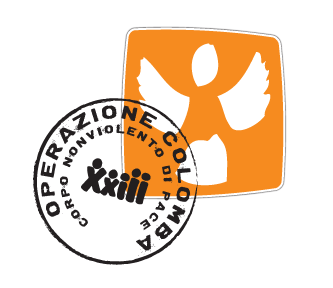Today there is a strange warm fog enveloping the sun and the village. The air is still, nothing seems to move, even the colors are somber. This is my photograph today and I would like to keep it this way. Although the air is heavy, the mood is not. For one day I slept, I did not run, I did not scan the horizon.
Thoughts these days gravitate to the images and photographs I carry within me and try to describe.
A few days ago I was trying to balance a cup of tea on the tire of a car while using the camera to frame yet another settler's car passing by the house where I had slept. Too close. I was in Umm Dhorit. To call it a village is to give it a flattering but inaccurate size.
There are two houses with tin roofs held down by tires and pieces of concrete, two tents, a structure to house animals, and a lush vegetable garden.
A Palestinian family lives there, and my unattractive description of it - garden aside - is because their houses were demolished a few months ago by an Israeli bulldozer.
That is the reason I was there.
I am at the top of the garden, in front of me crawls a dirt road that was recently drawn to connect two Israeli colonies with related outposts.
One is on my left, Avigayil, the other is just behind me, Mitzpe Yair.
Climbing over the dirt road, on the hill in front of where I stand, is a pile of objects that appear to have been abandoned seemingly at random.
A bus, a car, some hay covered with a white tarp, canisters of water, and the skeleton of what looks like it could be a house.
This skeleton is the most obvious warning to the less aware eye that what we are seeing are not objects left at random.
There is nothing random about the creation of an outpost. Those objects are there to take up space.
Before the settlers arrive, they serve as a signal that you, as a Palestinian, can no longer pass through there, that land is no longer accessible and will soon be inhabited by settlers.
Indeed, as scripted, there they are coming from the settlement on my left on top of an ATV -- the noise of which I have begun to hate -- carrying wooden planks to continue working on that skeleton.
Yesterday three of them arrived on the same ATV, M16s resting on their laps, followed by a drone that wanted to photograph us. They circled us a couple of times.
From the volunteers who were on the hill immediately after ours, we knew that they had just attacked two Palestinian shepherds grazing where they were.
Now they had come to us. They made their rounds and left.
The father of the family went back to build the ladder he was making in the garden, I breathed a sigh of relief, which was short-lived, because two settlers came to graze sheeps in the lower part of the garden.
I wish I could bring back something other than just pictures.
If I had to condense my frustration into a single theme, it all lies in the tension between images and living in this land.
Since the beginning of the war in Gaza, we have witnessed an ocean of images overwhelming us.
The first genocide shared on Instagram and Tik Tok.
Since coming to At-Tuwani the only channel I feel I have is images, whether they are conjugated in words or photographs.
But it is never enough. Words betray me and images don't live up to it.
I also get tired of saying, “You should come here to understand,” which I know to be true but inaccessible to most.
Partly because I would not want everyone to have to experience an occupation or genocide to understand that it is wrong, and to understand all the nuances of why it is wrong.
There are not enough images I can tell you about to convey to you the complexity and beauty of this place.
I also refrain from recounting them because I know that within the confines of language, whatever vocabulary I might choose, the reactions will range from “ ‘ those poor people’ to ‘this is terrible,’ to ‘but what do they think about Hamas.’”
I agree with the sense of injustice, I do not agree with the pity that creeps into these comments, nor with the historical-political inaccuracy of the obsession the West has with Hamas.
How do I share with you what it is like to witness all the ramifications, even the more insidious ones, of colonialism, without lapsing into easy rhetoric and without giving a history lesson?
Perhaps so, but I must return to tell an image.
Behind Umm Dhorit is another Palestinian village, very close to the Mitzpe Yair settlement.
It is called Simri.
The settlers terrorized the residents of Simri to the point that they had to leave, and now settlers live in those houses.
They would like the same thing to happen in Umm Dhorit, and they are working hard to make it happen.
I got a taste: constant patrols, the ATV mentioned above, drones, settler shepherds entering your land.
Other volunteers have been awakened at dawn because two settlers, dressed as soldiers with sneakers on - an important detail, it is always helpful to welcome ridicule when it arises - entered Palestinian property to take photos.
A few weeks ago they came in and burned the family's car.
Yesterday they came in and sat on their couches.
In this constant lottery, you get a different intimidating number every hour.
Despite this, you continue to work the land, there are sheep to graze, and taboon - typical Palestinian bread - does not bake itself.
Umm Dhorit is just one example, at this particularly heated moment, of how the occupation takes away your land, sleep, home, health, the possibility of imagining a future.
Yet you move forward, day after day, stubborn and resolute, to the tune of “one day we will take it all back.”
I find myself not knowing how to close this story because it is anything but closed.
I can describe images to you, I can even show them to you.
I can share with you videos of settlers arriving masked, of the army firing at checkpoints, as if there were not already thousands of videos and images documenting with terrible clarity the genocide that has been going on for 76 years.
But the images and videos freeze a sliver of time, alone they are not enough to weave canvases of meaning.
I arrived in 2016, like so many volunteers before and after me; I have seen children grow, I have built relationships that continue, I have also grown because of this land.
Every time I leave I feel that a little piece of me breaks away and stays here, not because I feel that I belong here but because the relationships that are created, even the most strenuous ones, make you live in this temporal dimension where the occupation is not detached from you, it does not affect you just because you were passing by, and it does not end when you leave.
You share, though in a different and smaller way, the more or less visible wounds that the occupation leaves behind, and you also share the stages of life that continue: marriages, graduations, children, homes.
This cannot be encapsulated in a picture.
M.



 OPERAZIONE COLOMBA
OPERAZIONE COLOMBA
